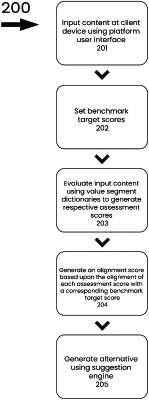| CPC G06F 40/157 (2020.01) [G06F 16/3329 (2019.01)] | 20 Claims |

|
1. A method for evaluating and generating content for a target audience, the method comprising:
clustering consumer data to define one or more statistically distinct values segments wherein each values segment corresponds to an audience group associated with a set of ranked and specified personal values, wherein each of the personal values is associated with a motivational basis for behavior;
for each values segment of the one or more values segments, generating an associated values segment dictionary based on the personal values associated with the audience group corresponding to the values segment, wherein the associated values segment dictionary includes terms, comprising words or phrases, likely to appeal to a member of the audience group;
responsive to receiving electronic document content, performing two or more alignment evaluations, including an alignment evaluation corresponding to each of two or more types of alignment evaluations, to determine two or more alignment scores, wherein each alignment score is indicative of an extent to which the document content reflects or has affinity to characteristics of the audience group, wherein the two or more types of alignment evaluations include:
a values-type alignment evaluation to determine a values alignment score indicative of a degree to which terms in the document content align with terms in the associated values-segment dictionary, wherein terms in the associated values-segment dictionary are determined based on a machine learning and natural language processing model of terms associated with the personal values of the audience group; and
a second-type of alignment evaluation, distinct from the values-type of alignment evaluation;
accessing benchmark scores including a benchmark score corresponding to each of the two or more types of alignment evaluations, wherein each of the benchmark scores reflects a user-defined alignment objective for a corresponding one of the two or more types of alignment evaluations;
comparing an alignment score of the two or more alignment scores to a corresponding one of the two or benchmark scores;
responsive to detecting the alignment score for at least a portion of the document content not meeting the corresponding benchmark score, providing a user interface including a visually detectable indication of the portion of the document content; and
responsive to a user selection of the visually detectable indication of the portion of the document content, generating one or more content suggestions to replace the portion of the document content and increase the overall alignment score.
|